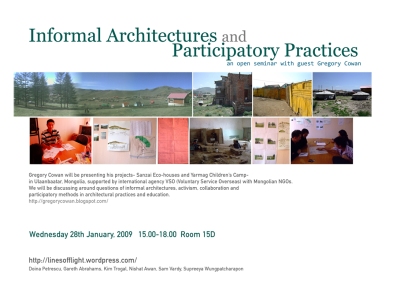Ulaanbaatar is increasingly comprised of and surrounded by ger districts (Mongolian tent dwelling districts), the informal architecture of encampments claimed by Mongolians under their traditional right to nomadically and temporarily settle on their land, in this case close to the capital. Now more than a colonial symbol, the capital is an increasingly environmentally repulsive complex, albeit of great financial and cultural attraction for Mongolian citizens.
Dirty yet progressive, ill-equipped yet full of potential for poor migrants, the chimera of gleaming towers at the city centre attract citizens of Mongolia from the farthest corners of the vast and relatively sparsely populated Republic.
In the process, the city's solitary East-West artery, symbolic of distant connections to Russian and Chinese neighbours, is completely clogged with private and 'SUV' vehicles and ailing microbuses, buses and trolleybuses, all heaving with passengers. The 4x4 vehicles in this predominantly rural country make for a perpetual Naadam festival, parading along Peace Avenue, demonstrating 'progress' and creating havoc for pedestrian and public transport. The latter are regarded the upwardly mobile as more symbolic of the bad old solicalist times, where the streets were deserted and people queued sliently for five identical grocery items at any one of the identical grocery stores throughout the city. Now the 4x4 owners, returning from their summer camps in the countryside, complain that the smog and haze is the product of the ger district residents burning coal for heating in the informally planned peri-urban areas.
From my window in the gridded high rise apartment subdivision, I look out over the informal district to see a horse and cart loaded with belongings bound for an unsealed track to the north. One of many vapour trails from the north west leading to the south east reminds me of the extremely high technology of international jet engines, while coal smoke puffs from chimeys in the unsewered and waterless ger district.
The informal urbanism of the ger area is horizontal and rhizomic, constantly changing and metamorphosing. My north facing window in building 23 represents the threshold of the vertical gridded, arboric city system 'core'. Women and children collect water and coal while men attend to ger covers, smoking cigarettes and jockeying cars.
Besides gers there are myriad fences and gates along a labyrinth of dusty vehicle paths and footways, stretching organically over the landscape, under power lines and around drain culverts. Tiny shops appear in shacks or recycled railway carriages or shipping containers. Small hourly rate hotels, a community centre and garages are interspersed without apparent planning logic. Empty space becomes a meeting point for 'taxi' drivers to gather or for another stall. The informal architecture here is woven or knitted together, temporarily, without a concern for the future.
Monday, December 10, 2007
Subscribe to:
Post Comments (Atom)



No comments:
Post a Comment